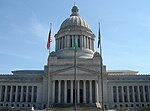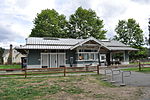Oregon Country was a large region of the Pacific Northwest of North America that was subject to a long dispute between the United Kingdom and the United States in the early 19th century. The boundaries of the area, which had been created by the Treaty of 1818 without recognizing indigenous claims to the area, consisted of the land north of 42° N latitude, south of 54°40′ N latitude, and west of the Rocky Mountains down to the Pacific Ocean and east to the Continental Divide. Article III of the 1818 treaty gave joint control to both nations for ten years, allowed land to be claimed, and guaranteed free navigation to all mercantile trade. However, both countries disputed the terms of the international treaty. Oregon Country was the American name while the British used Columbia District for the region. Meanwhile, Indigenous nations had lived in the area since time immemorial, though with little legal recognition in the American and British legal systems. Evidence along the Salmon River shows people lived there at least 16,000 years ago, and may have populated the continent after migrating along the Pacific Coast, then following up the Columbia River into the interior.British and French Canadian fur traders had entered Oregon Country prior to 1810 before the arrival of American settlers from the mid-1830s onwards, which led to the foundation of the Provisional Government of Oregon. Its coastal areas north from the Columbia River were frequented by ships from all nations engaged in the maritime fur trade, with many vessels between the 1790s and 1810s coming from Boston. The Hudson's Bay Company, whose Columbia Department comprised most of the Oregon Country and north into New Caledonia and beyond 54°40′ N, with operations reaching tributaries of the Yukon River, managed and represented British interests in the region.After the dispute became an election issue in the 1844 U.S. presidential election, the United Kingdom and the United States agreed to settle the problem with the Oregon Treaty in 1846. It established the British-American boundary at the 49th parallel (except Vancouver Island). With the end of joint occupancy, the region south of the 49th parallel became Oregon Territory in the United States while the northern portion became part of the British colonies of British Columbia and Vancouver Island. The area which once encompassed Oregon Country now lies within the present-day borders of the Canadian province of British Columbia and the entirety of the U.S. states of Oregon, Washington, and Idaho, as well as parts of Montana and Wyoming.









